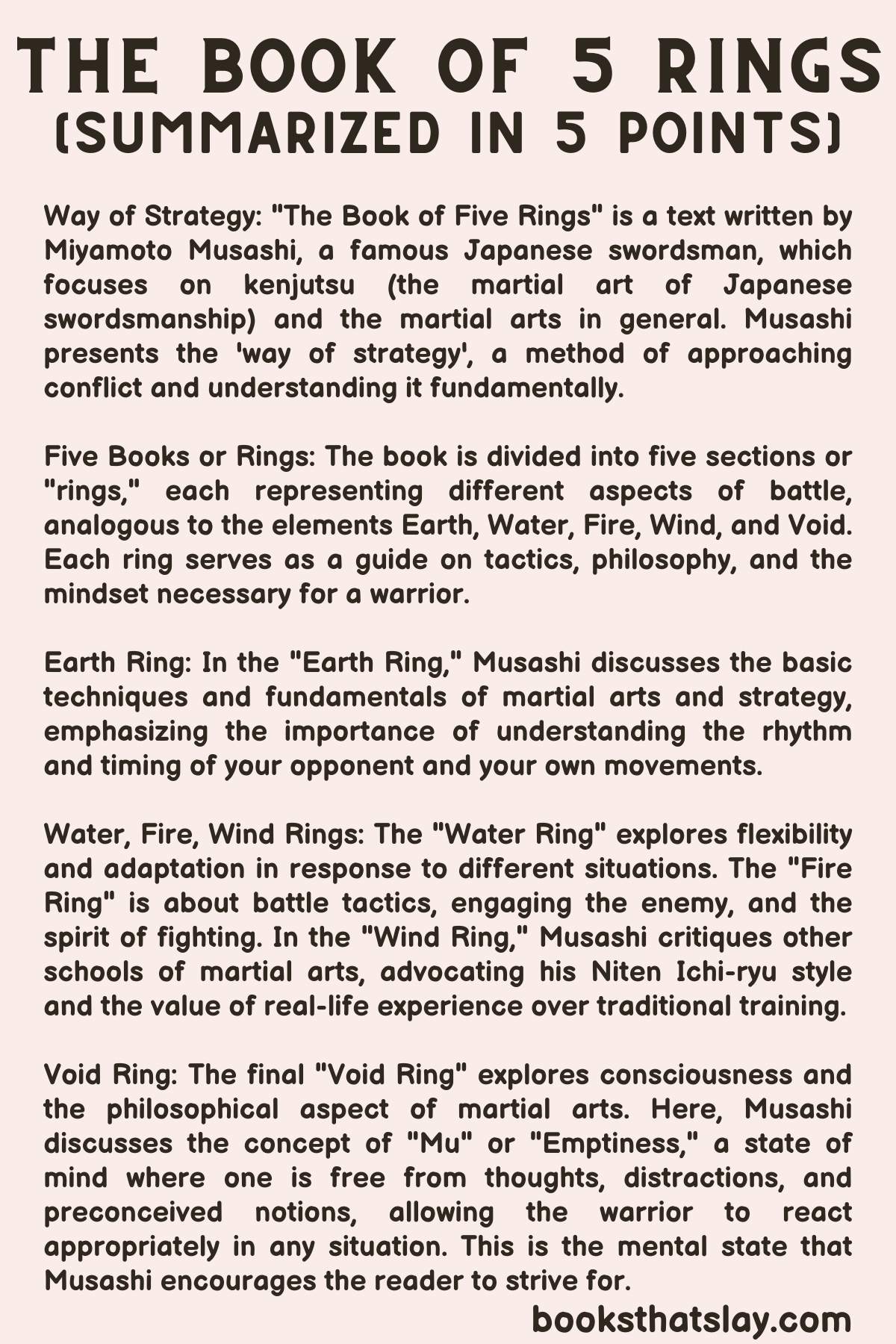The Book of Five Rings Summary and Key Lessons
“The Book of Five Rings” (Go Rin No Sho) is a classic treatise on strategy and martial arts, written in 1645 by Miyamoto Musashi, a renowned Japanese swordsman.
The book is divided into five sections or ‘books’, each corresponding to an element in Buddhist philosophy: Earth, Water, Fire, Wind, and Void. Musashi utilizes these elements to illustrate strategic concepts, and he further explores the metaphysical aspects of warfare, martial arts, and life.
The Book of Five Rings Summary
Here is a more detailed summary of each book:
1. Book of Earth
This book lays the groundwork for understanding the text.
Musashi discusses the importance of broad knowledge and strategic thinking, emphasizing that the path of the warrior is one that requires constant learning, not just about martial arts, but also about the world.
He introduces the concept of the “Way of the Warrior” (Bushido) and his own style, Niten Ichi-ryū, a two-sword technique.
The strategy includes understanding your opponent’s strengths and weaknesses and knowing the right time to attack or defend.
2. Book of Water
In the Book of Water, Musashi delves into the principles and techniques of his two-sword style.
This book uses the metaphor of water to explain the fluid and adaptable nature of combat.
Water molds itself to the shape of its container, moves freely, and can be both gentle and powerful.
Musashi encourages the reader to mirror these attributes in their approach to combat, remaining flexible, adapting to the situation, and mastering control over their strength and movements.
3. Book of Fire
The Book of Fire deals with the heat and immediacy of battle.
It discusses the mental state required during combat, how to read the enemy’s movements and the psychology of warfare.
Musashi emphasizes maintaining composure, even in the heat of battle, as critical to achieving victory.
He also details specific strategies for engaging an enemy and creating opportunities to strike.
4. Book of Wind
The Book of Wind examines other martial arts schools and their techniques, contrasting them with his own style. Musashi critiques their methods, using this analysis to further reinforce the principles of his own school of thought.
The “wind” here signifies the influences and fads that sway martial arts, which Musashi urges his readers to see through and instead, focus on the fundamental principles.
5. Book of Void
The final book, the Book of Void, is a brief discourse on consciousness and the true nature of existence, capturing the Zen aspect of Musashi’s teachings.
He discusses the concept of “emptiness,” a state of mind where one is free from thoughts, distractions, and preconceptions during combat, which leads to an intuitive understanding of the enemy’s moves and strategy.
This state of mind also allows the warrior to respond instinctively and instantly to their opponent’s actions.

Key Lessons
1. “The Way is in Training”
Discipline and consistent practice is important in achieving mastery.
This is embodied in the phrase, “The Way is in Training”
Musashi’s life exemplified this philosophy, as he honed his skills tirelessly through countless duels and rigorous personal training.
This isn’t limited to martial arts; it’s a universal principle applicable in business, sports, arts, academics, or any field.
Mastery requires diligent practice, persistence, and a lifelong commitment to learning and self-improvement.
2. “Understand the Harm and Benefit in Everything”
A powerful lesson in strategic thinking and decision-making, Musashi emphasizes a deep and thorough understanding of one’s circumstances, including potential advantages and disadvantages.
He demonstrated this in his duels, where he keenly observed his opponents’ techniques, demeanor, and environment before striking.
In a modern context, for a business leader, this might mean conducting a comprehensive market analysis, understanding competition, and staying updated with industry trends before making strategic decisions.
3. “Perceive That Which Cannot Be Seen With The Eye”
This principle encourages developing an intuitive understanding beyond what is immediately apparent or superficial.
Musashi often wrote about the importance of perceiving the ‘unseen,’ which in his context was anticipating an opponent’s moves in a duel. In contemporary terms, this could translate into understanding the subtler aspects of a situation, like the morale of a team, unspoken concerns of a client, or potential future trends in a marketplace.
This deep perception, according to Musashi, can give an edge in any competitive scenario.
4. “Do Not Seek Pleasure for its Own Sake”
This is not a call to asceticism but a reminder that fleeting pleasures can become distractions that pull us away from our path.
For example, a student might choose to sacrifice immediate pleasures like excessive partying or entertainment to focus on their studies and achieve their academic goals.
Similarly, a startup founder might need to forego immediate monetary rewards to ensure the long-term success and sustainability of their venture.
Final Thoughts
“The Book of Five Rings” is not merely a manual on martial arts but also a profound work on strategy, philosophy, and human psychology. It’s widely regarded as a classic and is studied by business strategists, martial artists, and those interested in Eastern philosophy.